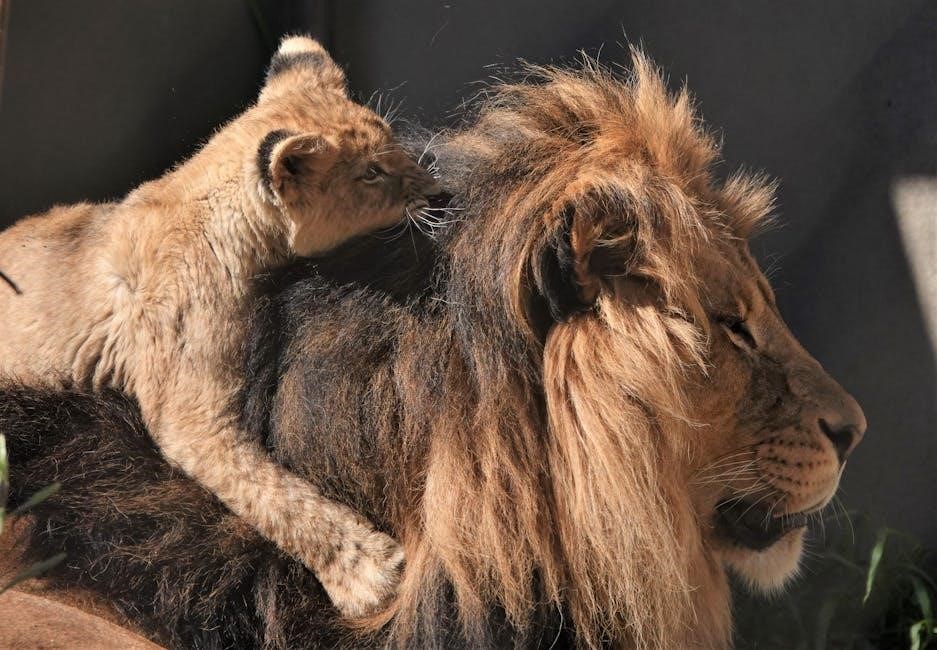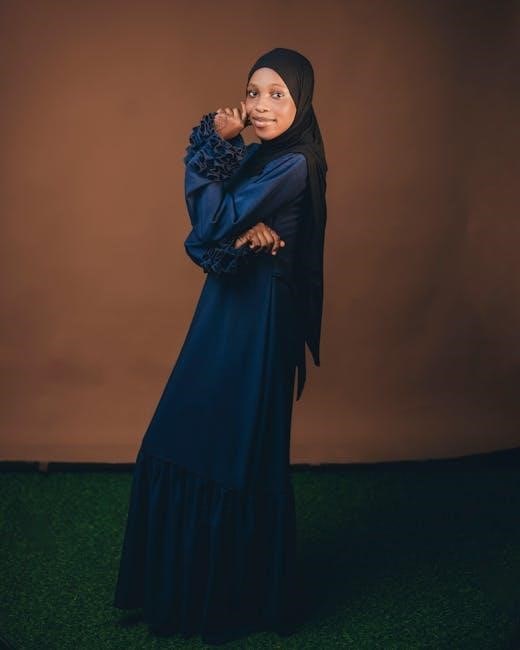the lion witch and wardrobe pdf
- Published
- in United Kingdom
The Lion, the Witch, and the Wardrobe is a timeless classic by C.S. Lewis, part of The Chronicles of Narnia series; The story follows the Pevensie children as they discover a magical land through a wardrobe. This iconic tale explores themes of sacrifice, redemption, and the battle between good and evil. The PDF version of the book is widely available, offering readers a convenient way to access this beloved story on various devices, ensuring its magic endures for generations.
Overview of The Chronicles of Narnia
The Chronicles of Narnia is a beloved fantasy series by C.S. Lewis, comprising seven enchanting books. The series transports readers to the magical land of Narnia, a realm inhabited by talking animals, mythical creatures, and timeless moral lessons. Central to the series is the struggle between good and evil, with iconic characters like the White Witch and Aslan symbolizing opposing forces. The stories follow various protagonists as they navigate Narnia’s transformative world, encountering adventures, sacrifices, and redemptive journeys. The series is celebrated for its rich imagery, allegorical themes, and universal appeal to readers of all ages. The Lion, the Witch, and the Wardrobe stands as the most famous installment, introducing many to Narnia’s wonders. Its availability in PDF format has made it easily accessible, ensuring its magical tales continue to captivate audiences worldwide.
The Lion, the Witch, and the Wardrobe as the First Book
The Lion, the Witch, and the Wardrobe is the first book in The Chronicles of Narnia series, published in 1950. It serves as the gateway to the magical world of Narnia, introducing readers to a land of wonder and conflict. The story follows the Pevensie siblings, who discover Narnia through a wardrobe, setting the stage for their adventures. This book is central to the series, as it establishes key themes and characters, such as Aslan and the White Witch, who symbolize good and evil. The PDF version of this book is widely sought after, as it allows readers to easily access and enjoy the timeless tale. Its availability in digital format has made it more accessible, ensuring that new generations can experience the enchantment of Narnia with ease and convenience.

Plot Summary
The story follows the Pevensie children as they enter Narnia through a wardrobe, encountering a land ruled by the White Witch. Aslan’s sacrifice and resurrection lead to a climactic battle, culminating in their victory and coronation as kings and queens of Narnia.
The Pevensie Children
The Pevensie children—Peter, Susan, Edmund, and Lucy—are the central characters in The Lion, the Witch, and the Wardrobe. Evacuated from London during World War II, they find refuge in a large, old house. While exploring, Lucy discovers the magical land of Narnia through a wardrobe. Her siblings initially doubt her story but later follow her into Narnia. Each child plays a crucial role in the story: Lucy’s curiosity and bravery, Susan’s practicality, Edmund’s initial betrayal and redemption, and Peter’s growth from hesitation to leadership. Their experiences in Narnia shape their characters and bond as they face challenges alongside Aslan and against the White Witch. Their journey symbolizes personal growth, forgiveness, and the triumph of unity in the face of adversity.
The Discovery of Narnia
The discovery of Narnia unfolds during the evacuation of the Pevensie children to the countryside amidst World War II. While exploring the vast, old house of Professor Kirke, Lucy, the youngest sibling, stumbles upon a mysterious wardrobe tucked away in a dusty room. Driven by curiosity, she steps inside, only to find herself in a magical land blanketed in snow. The wardrobe serves as a portal to Narnia, a realm ruled by the White Witch, where talking animals and ancient magic reign. Lucy’s encounter with Mr. Tumnus, a friendly faun, introduces her to this enchanted world. Her siblings later follow, leading them into a world of wonder and conflict. This pivotal moment sets the stage for their adventures and the battle between good and evil in Narnia, forever changing their lives and understanding of courage and sacrifice.
Aslan and the White Witch

At the heart of The Lion, the Witch, and the Wardrobe lies the epic struggle between Aslan, the great lion, and the White Witch, Jadis. Aslan, a symbol of wisdom, courage, and redemption, represents the force of good in Narnia. The White Witch, with her icy grip and magical powers, embodies evil, having cast a spell to make Narnia forever winter but never Christmas. Their confrontation is inevitable, as Aslan seeks to free Narnia from her tyranny. The White Witch’s power is formidable, but Aslan’s sacrifice and resurrection mark a turning point in the story. Their rivalry drives the narrative, showcasing themes of sacrifice, redemption, and the ultimate triumph of good over evil. This conflict is central to the story, shaping the fate of Narnia and its inhabitants.
The Battle and Sacrifice
The climactic battle between good and evil unfolds on the plains of Beruna, where Aslan’s forces confront the White Witch’s army. The Pevensie children, now kings and queens, play pivotal roles in the conflict. Aslan, knowing his destiny, willingly sacrifices himself to save Edmund, who had betrayed his siblings. The White Witch executes Aslan on the Stone Table, a moment of profound sorrow. However, through the “deep magic,” Aslan is resurrected, symbolizing his divine power and the triumph of sacrifice over evil. This pivotal event galvanizes Aslan’s followers, leading to a fierce and decisive battle against the Witch’s forces. The sacrifice and resurrection of Aslan mark a turning point, inspiring hope and unity among the Narnians, ultimately paving the way for their victory.
Victory and Coronation
Following the defeat of the White Witch, Narnia is restored to its former glory. The Pevensie children, hailed as heroes, are crowned kings and queens of Narnia in a grand coronation ceremony. Peter, the High King, rules with wisdom, while Susan, Lucy, and Edmund govern their respective territories. The land flourishes under their just and compassionate leadership, marking the beginning of Narnia’s Golden Age. The coronation symbolizes the triumph of good over evil and the fulfillment of the prophecy. Aslan, now a guiding figure, ensures peace and prosperity throughout the realm. The Pevensies’ reign brings harmony, and their bond with Narnia and its creatures deepens, leaving a lasting legacy. The coronation serves as a celebration of freedom, hope, and the enduring power of courage and sacrifice.

Themes
Central themes in The Lion, the Witch, and the Wardrobe include sacrifice, redemption, good vs. evil, hope, and resilience, enriching the story’s depth and universal appeal.
Sacrifice and Redemption
At the heart of The Lion, the Witch, and the Wardrobe lies the profound theme of sacrifice and redemption. Aslan’s willingness to lay down his life for Edmund exemplifies the ultimate act of sacrifice, symbolizing love, forgiveness, and the triumph of good over evil. His resurrection embodies redemption, not only for Edmund but for all of Narnia, highlighting the transformative power of selfless love. The Pevensie children also learn the value of sacrifice, as they risk their lives to protect one another and Narnia. These acts of sacrifice and redemption underscore the story’s Christian allegory, offering a timeless message of hope, forgiveness, and the possibility of redemption, even in the face of darkness and betrayal.
Good vs. Evil
In The Lion, the Witch, and the Wardrobe, the struggle between good and evil is a central theme. Aslan, the benevolent lion, represents goodness, wisdom, and sacrifice, while the White Witch symbolizes evil, tyranny, and oppression. The Witch’s rule over Narnia with an iron fist, turning creatures to stone and casting a perpetual winter, contrasts sharply with Aslan’s vision of freedom, justice, and renewal. The Pevensie children are drawn into this conflict, with Edmund initially succumbing to the Witch’s deceit before redeeming himself. The battle between Aslan’s forces and the Witch’s army serves as a climactic showdown between light and darkness. Ultimately, good triumphs through Aslan’s resurrection and the Witch’s defeat, reinforcing the idea that courage, love, and righteousness will always prevail over malice and domination.
Hope and Resilience
The Lion, the Witch, and the Wardrobe profoundly explores hope and resilience through its characters and narrative. The Pevensie children, particularly Lucy, embody hope as they navigate the challenges of Narnia. Despite the White Witch’s oppressive rule, Lucy’s unwavering belief in Aslan and the true nature of Narnia inspires others to hold onto hope. Edmund’s journey from betrayal to redemption highlights resilience, as he learns to confront his mistakes and fight for what is right. Aslan’s sacrifice and resurrection symbolize the ultimate triumph of hope over despair. The story teaches that even in the darkest times, resilience and faith can lead to renewal and victory. This theme resonates deeply, offering readers a powerful message about perseverance and the enduring power of hope in the face of adversity.

Symbolism
The Lion, the Witch, and the Wardrobe is rich in symbolism, representing universal themes like sacrifice, redemption, and the struggle between good and evil through its magical world and characters.
The Wardrobe as a Portal
The wardrobe serves as a magical portal connecting the ordinary world of 1940s England to the enchanted land of Narnia. This ordinary piece of furniture transforms into an extraordinary gateway, symbolizing transition, exploration, and the idea of stepping into the unknown. Its role as a portal highlights the theme of discovery, where the Pevensie children unintentionally stumble upon a world beyond their imagination. The wardrobe’s dual nature—its mundane appearance hiding a magical secret—mirrors the human experience of finding the extraordinary within the ordinary. This symbolic element is central to the story, representing the possibility of escaping reality and encountering a world of wonder. The wardrobe’s significance extends beyond its physical form, embodying the idea of thresholds and the courage required to cross them.
The White Witch’s Magic
The White Witch, Jadis, wields powerful magic that dominates Narnia, casting a spell of eternal winter without Christmas. Her magic is rooted in dark sorcery, symbolizing her tyrannical rule and desire for control. She uses enchantments to manipulate others, turning them into stone with a mere touch. This magic underscores her cruelty and oppressive reign, creating a world where fear and submission prevail. However, her powers are not limitless, as they are eventually countered by Aslan’s divine authority. The White Witch’s magic represents the corrupting influence of absolute power and the oppressive nature of evil. Her spells and incantations serve as tools to maintain her dominance, but they also highlight the fragility of her rule when faced with the forces of good.
Aslan as a Symbol of Goodness
Aslan, the lion, is a powerful symbol of goodness, embodying wisdom, courage, and selflessness. He serves as the moral compass of Narnia, representing divine authority and justice. His deep wisdom guides the Pevensie children and other characters, while his courage inspires them to stand against evil. Aslan’s selflessness is most evident in his willingness to sacrifice himself for Edmund, demonstrating the depth of his love and commitment to redemption. His resurrection symbolizes hope, renewal, and the triumph of good over evil. Aslan’s character also reflects themes of forgiveness and mercy, as he offers second chances and leads Narnia toward healing. His presence in the story underscores the idea that true goodness is not only powerful but also compassionate and transformative.
PDF Version
The Lion, the Witch, and the Wardrobe PDF offers a convenient reading experience. The digital format allows readers to access the story on various devices, maintaining the original charm and accessibility.
Downloading the PDF Legally
Downloading The Lion, the Witch, and the Wardrobe PDF legally ensures compliance with copyright laws and supports authors and publishers. Official sources like publishers’ websites or authorized eBook platforms provide secure and high-quality downloads.Sites like Amazon Kindle, Google Play Books, or Barnes & Noble Nook offer legitimate copies, often with customizable reading settings. Purchasing or downloading from these platforms guarantees an uninterrupted reading experience. Additionally, libraries may offer free digital loans through services like OverDrive or Libby, requiring only a valid membership. Legal downloads prevent exposure to malware and ensure the file’s integrity. By choosing legal options, readers contribute to the sustainability of literary works and respect the creative efforts behind them.
Features of the PDF
The PDF version of The Lion, the Witch, and the Wardrobe offers a seamless reading experience with high-quality formatting that preserves the original text and illustrations. The file is optimized for readability on various devices, ensuring clarity on both small screens and larger displays. Many versions include interactive features such as bookmarks, a hyperlinked table of contents, and adjustable font sizes for customization. Illustrations from the book are often retained in the PDF, enhancing the story’s magical atmosphere. Additionally, the PDF format allows for easy navigation, with features like page numbering and search functionality. This makes it ideal for students or readers who need to reference specific sections quickly. The file size is typically compact, making it easy to download and store without occupying excessive space on devices.
Compatibility Across Devices
The PDF version of The Lion, the Witch, and the Wardrobe ensures a seamless reading experience across a wide range of devices. Whether accessed on a smartphone, tablet, e-reader, or desktop, the PDF format adapts effortlessly to different screen sizes and resolutions. This compatibility allows readers to switch devices without losing their place or experiencing formatting issues. The file is optimized for both iOS and Android devices, as well as e-readers like Amazon Kindle and Barnes & Noble Nook. Additionally, it works seamlessly with popular eBook apps such as Apple Books and Google Play Books. The PDF’s portability ensures that fans of the story can enjoy it on any device, making it a convenient option for reading on the go or sharing with others. This flexibility enhances accessibility and ensures a consistent reading experience.

Adaptations
The Lion, the Witch, and the Wardrobe has been adapted into movies, stage plays, and audiobooks, broadening its reach and engaging audiences in diverse formats, complementing the PDF version.
Movie Adaptations
The 2005 film adaptation of The Lion, the Witch, and the Wardrobe, directed by Andrew Adamson, brought C.S. Lewis’s timeless story to life with stunning visual effects and a faithful retelling of the narrative. Produced by Walden Media and 20th Century Fox, the movie starred Tilda Swinton as the White Witch and Liam Neeson as the voice of Aslan. The film grossed over $745 million worldwide, becoming a critical and commercial success. It captured the magical essence of Narnia, blending action, emotion, and fantasy, while remaining true to the original book’s themes of sacrifice and redemption. The movie’s success led to two sequels, Prince Caspian and The Voyage of the Dawn Treader, solidifying the series’ place in cinematic history and introducing the story to a new generation of fans.
Stage Play Adaptations
The Lion, the Witch, and the Wardrobe has been adapted into numerous stage plays, captivating audiences with its magical storytelling and universal themes. The first major stage adaptation was produced in the 1980s, with the Royal Shakespeare Company bringing the story to life through elaborate costumes and creative staging. Since then, various theater groups worldwide have created their own interpretations, often incorporating puppetry, projections, and innovative set designs to portray Narnia’s fantastical world. Notable productions include those in London’s West End and on Broadway, where the story’s emotional depth and epic battles have resonated deeply with audiences. These adaptations remain faithful to the original narrative while adding unique theatrical elements, offering fans a fresh way to experience the timeless tale of courage, sacrifice, and redemption.
Audiobook Versions
The Lion, the Witch, and the Wardrobe has been beautifully adapted into audiobook formats, offering listeners a immersive way to experience the magical world of Narnia. Renowned narrators like Michael York and Kenneth Branagh have brought the story to life with their captivating voices, enhancing the emotional depth and adventure. Many audiobook versions include sound effects and music to create a richer listening experience. These adaptations are particularly popular for their portability, allowing fans to enjoy the story during commutes or while relaxing. The audiobook format has also made the story accessible to a wider audience, including those who prefer listening over reading. With its enduring themes and vivid storytelling, The Lion, the Witch, and the Wardrobe remains a beloved choice in audiobook collections worldwide.

Educational Resources
Educational resources for The Lion, the Witch, and the Wardrobe include study guides, discussion questions, and lesson plans, helping students engage with the story’s themes and symbolism.
Study Guides
Study guides for The Lion, the Witch, and the Wardrobe provide comprehensive analysis and insights into the novel. These guides are designed to help students and educators explore themes, characters, and symbolism in depth. They often include chapter summaries, discussion prompts, and critical essays to enhance understanding. Many study guides are available in PDF format, making them easily accessible for classroom or independent study. They typically cover key themes such as sacrifice, redemption, and the struggle between good and evil. Additionally, these resources may include character analyses, focusing on figures like Aslan, the White Witch, and the Pevensie children. Study guides also often feature vocabulary lists and comprehension questions to aid in learning. They are invaluable tools for teaching and studying the novel, offering a structured approach to unpacking its rich narrative and moral lessons. They cater to various educational levels, ensuring accessibility for all learners.
Discussion Questions
Discussion questions for The Lion, the Witch, and the Wardrobe are designed to deepen understanding and encourage reflection. They often focus on themes like courage, sacrifice, and morality. Questions might explore the symbolism of the wardrobe as a portal to Narnia or the role of Aslan as a symbol of redemption. Some prompts invite readers to analyze the Pevensie children’s growth throughout the story or the motivations of the White Witch. Additionally, questions may address the battle between good and evil, the significance of the stone table, and the coronation of the Pevensies. These questions are ideal for book clubs, classrooms, or personal study, fostering meaningful conversations about the novel’s rich themes and characters.

Lesson Plans

Lesson plans for The Lion, the Witch, and the Wardrobe are designed to engage students in exploring the novel’s themes, characters, and literary elements. Teachers can incorporate activities such as reading comprehension exercises, character analysis, and creative writing tasks. For instance, students might create a timeline of key events or write diary entries from the perspective of a Pevensie sibling. Discussions can focus on themes like sacrifice, redemption, and courage. Additionally, lesson plans may include comparing the book with its adaptations to analyze storytelling techniques. PDF versions of the book can be integrated with digital tools for interactive reading experiences. These plans cater to different learning styles, ensuring students deepen their understanding of the story while developing critical thinking and writing skills.
The Lion, the Witch, and the Wardrobe remains a timeless tale of courage, sacrifice, and hope. Its availability in PDF format ensures accessibility, preserving its magic for future readers.
Importance of the Book
The Lion, the Witch, and the Wardrobe is a timeless classic that has captivated readers for generations. Its enduring popularity stems from its ability to transport readers to the magical land of Narnia, offering a rich tapestry of memorable characters and universal themes. The book’s exploration of sacrifice, redemption, and the struggle between good and evil resonates deeply, making it a must-read for audiences of all ages. Additionally, its availability in PDF format ensures that this beloved story remains accessible, preserving its magic for future generations. The story’s educational value is also significant, as it is often used in schools to teach literature and moral lessons. Overall, the book’s influence on literature and its place in the literary canon highlight its importance as a work that continues to inspire and educate readers worldwide.

Accessibility in PDF Format
The availability of The Lion, the Witch, and the Wardrobe in PDF format has significantly enhanced its accessibility for readers worldwide. This digital version allows the story to reach a broader audience, including those who may not have access to physical copies. The PDF format ensures compatibility across various devices, such as e-readers, tablets, and smartphones, making it easy to carry and read on the go. Additionally, features like adjustable font sizes and text-to-speech functionality make the book more accessible to visually impaired readers. The PDF version also preserves the original formatting and illustrations, maintaining the essence of the story. This accessibility ensures that the timeless tale of Narnia remains inclusive and convenient for readers of all abilities and preferences, fostering a love for reading across generations.
